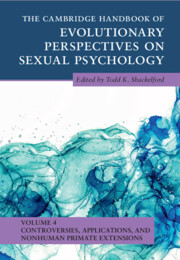Book contents
- The Cambridge Handbook of Evolutionary Perspectives on Sexual Psychology
- The Cambridge Handbook of Evolutionary Perspectives on Sexual Psychology
- Copyright page
- Contents
- Contributors
- Preface
- Part I Controversies and Unresolved Issues
- Part II Applications to Health, Law, and Pornography
- Part III Nonhuman Primate Sexual Behavior
- 14 Chimpanzee Sexual Behavior
- 15 Bonobo Sexual Behavior and Psychology
- 16 Orangutan Sexual Behavior
- 17 Gibbon Evolved Sexual Psychology
- 18 Sexual Behavior in Marmosets in the Context of Cooperative Breeding
- 19 Capuchin Sexual Behavior
- 20 Sexual Behavior in Neanderthals
- Index
- References
17 - Gibbon Evolved Sexual Psychology
from Part III - Nonhuman Primate Sexual Behavior
Published online by Cambridge University Press: 30 June 2022
- The Cambridge Handbook of Evolutionary Perspectives on Sexual Psychology
- The Cambridge Handbook of Evolutionary Perspectives on Sexual Psychology
- Copyright page
- Contents
- Contributors
- Preface
- Part I Controversies and Unresolved Issues
- Part II Applications to Health, Law, and Pornography
- Part III Nonhuman Primate Sexual Behavior
- 14 Chimpanzee Sexual Behavior
- 15 Bonobo Sexual Behavior and Psychology
- 16 Orangutan Sexual Behavior
- 17 Gibbon Evolved Sexual Psychology
- 18 Sexual Behavior in Marmosets in the Context of Cooperative Breeding
- 19 Capuchin Sexual Behavior
- 20 Sexual Behavior in Neanderthals
- Index
- References
Summary
Gibbons are the small-bodied Asian apes that comprise the taxonomic family Hylobatidae. In addition to small body size, gibbons are distinct from the large-bodied apes (i.e., orangutans, gorillas, bonobos, and chimpanzees) in a number of aspects of their behavior and biology. These traits include strict arboreality; sexual monomorphism for body and canine size; the production of loud complex calls, or songs; the joint defense of a fixed territory; and the tendency to live in small family groups with a single adult pair. While frequently described as monogamous, and even as “mating for life,” research over the last several decades has documented far greater diversity in gibbon social systems than was initially recognized, leading to a broad effort to reassess how best to characterize gibbon social systems and their origins. Nevertheless, as this review will demonstrate, much of what we know about gibbon sexual psychology and reproductive behavior is best understood in the context of small, one-male/one-female social groups.
- Type
- Chapter
- Information
- Publisher: Cambridge University PressPrint publication year: 2022



